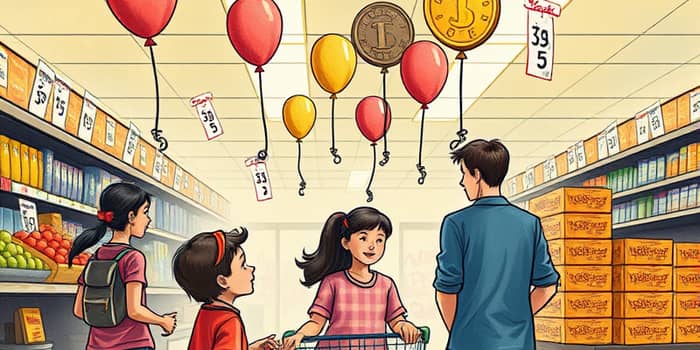Inflation touches every corner of our lives, from the price of morning coffee to long-term savings. Understanding its dynamics is decrease in the purchasing power and finding ways to adapt can empower you to thrive, even as costs rise.
Understanding Inflation: Definition and Measurement
At its core, inflation describes the steady rise in the average price of goods and services. As prices climb, each unit of currency buys less than before. Economists rely on price indices to measure this process and gauge economic health.
- Consumer Price Index (CPI): Tracks a basket of urban consumer goods and services.
- Personal Consumption Expenditures (PCE): Includes a broader range of household expenses, such as healthcare paid via insurance.
- Producer Price Index (PPI): Measures average changes in selling prices received by producers.
- GDP Price Index: Captures price changes for all final domestic goods and services.
The inflation rate is reported as a percentage change over a month or year, helping policymakers and consumers alike understand price trends.
Current Trends in Inflation for 2025
After turbulent pandemic years and supply chain disruptions, 2025 shows a more moderate pace. As of May, the U.S. annual inflation rate stands at 2.4%, with core inflation—excluding food and energy—hovering at 2.8%. The Consumer Price Index for All Urban Consumers (CPI-U) rose 3% year-over-year by January.
While these numbers suggest relative stability, upcoming factors—like tariff adjustments and lingering supply bottlenecks—could push prices higher in the months ahead.
Causes Behind Rising Prices
Inflation rarely stems from a single source. A mix of factors often drives overall price increases:
- Demand-pull inflation: When spending outpaces the economy’s ability to produce goods and services.
- Cost-push inflation: Rising production costs (raw materials, labor) pass through to consumer prices.
- Monetary inflation: Central banks expanding the money supply faster than output growth.
- Inflation expectations: If businesses and consumers anticipate higher prices, they act in ways that make those expectations self-fulfilling.
Recognizing the root causes helps individuals and policymakers craft targeted responses.
The Daily Impact: How Growing Prices Affect Your Wallet
When inflation accelerates, the first casualty is shrinking real incomes. That morning latte, monthly rent, and weekly grocery bill all demand a larger share of your paycheck.
During the 2021 spike, the average household spent an extra $3,500 annually just to maintain living standards. Food prices jumped 6.1%, energy soared 33.3%, and shelter costs increased 3.8%. Lower-income families felt the squeeze hardest, spending roughly 7% more on essentials, compared to 6% for higher earners.
These shifts force many households to make tough choices: cutting discretionary expenses, downgrading brands, or delaying big-ticket purchases like appliances or vacations.
Winners and Losers: Uneven Effects across Society
Not all price increases hit equally. Commodities (excluding food and energy) rose nearly 9.4%, while services climbed more modestly by 2.9%. Those on fixed incomes, such as retirees, find their budgets stretched further as living costs rise faster than social security or pension adjustments.
Meanwhile, borrowers may find it easier to repay fixed-rate loans, as inflation erodes the real value of debt. Savers, however, face a battle to keep interest earnings ahead of price growth.
Strategies to Protect Your Finances
Adapting to an inflationary environment requires strategic financial adjustments. Consider these steps:
- Build or reinforce an emergency fund to cover unexpected cost hikes.
- Review and optimize your budget, focusing on high-inflation categories.
- Explore inflation-protected investments, such as Treasury Inflation-Protected Securities (TIPS).
These measures can safeguard purchasing power and reduce stress when prices surge.
The Role of Policy: Central Banks and Beyond
Central banks target moderate inflation—around 2% annually—to balance growth and price stability. By adjusting interest rates, they influence borrowing costs and money supply. If inflation runs too hot, rate hikes cool economic activity; if too low, rate cuts aim to stimulate spending.
Fiscal policies, such as targeted subsidies or tax adjustments, also play a role in shielding vulnerable populations from sudden price shocks.
Looking Ahead: What Might the Future Hold?
Experts forecast inflation settling near pre-pandemic norms, but risks remain. Global supply chain shifts, energy market volatility, and geopolitical tensions could reignite price pressures.
Despite uncertainty, individuals equipped with knowledge and proactive plans can navigate these challenges. By monitoring inflation trends, adjusting spending habits, and exploring protective investments, you can turn economic headwinds into opportunities for resilience.
Ultimately, understanding what inflation is and how it operates is not just an academic exercise—it’s a powerful tool. Armed with this insight, you can make informed decisions, safeguard your savings, and continue moving toward your financial goals, no matter how the price level shifts.
References
- https://www.imf.org/en/Publications/fandd/issues/Series/Back-to-Basics/Inflation
- https://www.investopedia.com/terms/i/inflation.asp
- https://en.wikipedia.org/wiki/Inflation
- https://bungalow.com/articles/inflation-definition-and-how-it-affects-you
- https://tradingeconomics.com/united-states/inflation-cpi
- https://budgetmodel.wharton.upenn.edu/issues/2021/12/15/consumption-under-inflation-costs
- https://www.mckinsey.com/featured-insights/mckinsey-explainers/what-is-inflation
- https://www.pgpf.org/article/what-is-inflation-and-why-does-it-matter/










